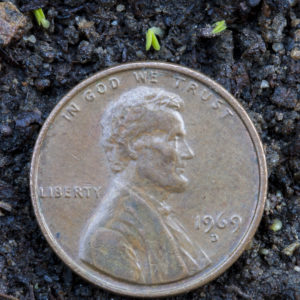NED Gardens Across America — Episode 5
https://www.neverenoughdirt.com
During the usual up-before-the-bees morning garden stroll, a female Xiyuan Sweet watermelon blossom was spotted. A corresponding male flower was located on a nearby plant and hand pollination ensued. Because the goal of this project is to seed save, the pollinated blossom is later wrapped in order to guard against cross-pollination by means of wind or insects.
During this exercise, we see that the Abigail’s Coffee okra is doing well. To our surprise, we discovered an okra sprout. Sowed in Episode 1 and talked about in subsequent episodes as sprouting failure, it popped out of the soil to let us know that it was down but not out.
Not to be out done, the Kirlangic melon shot out a female blossom for us to get excited about. The Powder Star beans, meanwhile, continued on with their pole dancing. This is a family show; as such they were not featured.














![#nedfirsts 'Gwen' avocado. My avocado growing journey began thirteen years ago in 2012. It took me far longer than expected to figure out how they like to be grown. Our first homegrown avocado was a 'Pinkerton' harvested last year (2024.)
Our literal second homegrown avocado is this 'Gwen.' The tree that produced it was received August 2022. Last year it was mature enough to hang onto fruit but I thinned it down to one; so the tree can continue to focus more energy towards growing.
This variety was patented in the 1980s by the University of California [patent expired, 02/17/2003.] With great commercial potential it was the crown jewel of avocados. However in the fields Gwen was found to be a diva. Additionally, unlike the Hass which turns black when ripe, Gwen remains mostly green. This lack of cuing the consumer along with its behavior in the field led Gwen to fall into oblivion.
For a long time, I sought a Gwen tree to plant. While continuing to keep my eyes peeled, I attempted to grow a Gwen offspring, the 'Reed' avocado. Then in 2019 I found @fourwindsgrowers. A few trees later, success!
Picture 3: The University of California prominently researches citrus, avocado, and strawberry. Gwen is pictured with 'Cam Sanh / King Tangor.' In their respective class, each is responsible for offspring that are presently in demand like 'Gold Nugget' mandarin and 'GEM' avocado.
Picture 4: Girth of the trunk
Picture 5: Gwen tree. Also draped with plants like hairy vetch, volunteer Asiatic poppy, and filet bean; to diffuse our strong California sun.](https://scontent.cdninstagram.com/v/t51.75761-15/490140300_18498506023012892_8135858133181254655_n.webp?stp=dst-jpg_e35_tt6&_nc_cat=106&ccb=1-7&_nc_sid=18de74&_nc_ohc=8qv_RodzojUQ7kNvwHqKcBL&_nc_oc=Adkg10Nj6ygKkAM_FmV5mGxGcSscVZWj6OE9JFCkfcGYzucYUmskORwGXH_gSeL96VBQxPmaYlQogYGdNIb-FvlJ&_nc_zt=23&_nc_ht=scontent.cdninstagram.com&edm=ANo9K5cEAAAA&_nc_gid=ObPXjEmz0F6rLua-NIhXkg&oh=00_AfRLXaJLdqQQmuN7HktBeSQ7WubuTsgslQpBtgIQGs0wXg&oe=68865F9F)






